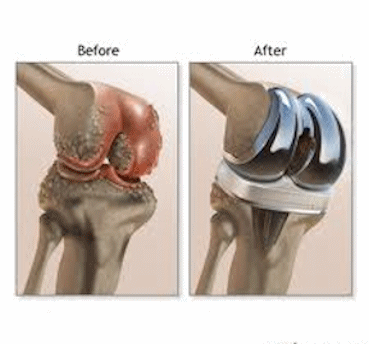




Knee replacement or knee arthroplasty is a surgical procedure to replace the weight-bearing surfaces of the knee joint to relieve the pain and disability of osteoarthritis. It may be performed for other knee diseases such as rheumatoid arthritis and psoriatic arthritis. In patients with severe deformity from advanced rheumatoid arthritis, trauma, or long standing osteoarthritis, the surgery may be more complicated and carry higher risk. Osteoporosis does not typically cause knee pain, deformity, or inflammation and is not a reason to perform knee replacement. Knee replacement surgery can be performed as a partial or a total Knee replacement. In general, the surgery consists of replacing the diseased or damaged joint surfaces of the knee with metal and plastic components shaped to allow continued motion of the knee.
A total knee replacement is a surgical procedure whereby the diseased knee joint is replaced with artificial material. The knee is a hinge joint which provides motion at the point where the thigh meets the lower leg. The thighbone (or femur) abuts the large bone of the lower leg (tibia) at the knee joint. During a total knee replacement, the end of the femur bone is removed and replaced with a metal shell. The end of the lower leg bone (tibia) is also removed and replaced with a channeled plastic piece with a metal stem. Depending on the condition of the kneecap portion of the knee joint, a plastic "button" may also be added under the kneecap surface. The artificial components of a total knee replacement are referred to as the prosthesis. Total knee replacement (arthroplasty) has proven to be a very effective surgical treatment of osteoarthritis of the knee for many years.
There are 5 main types of knee replacement surgery:
This is the most common form. Your surgeon replaces the surfaces of the thigh bone and shin bone that connects to the knee.
If arthritis affects only one side of your knee, this surgery may be a possibility. However, it's only right for you if you have strong knee ligaments and the rest of the cartilage in the knee is normal. Partial knee replacement can be performed through a smaller cut than is needed for total knee replacement.
This replaces only the under-surface of the kneecap and the groove the kneecap sits in. This can be very effective for people with chronic kneecap arthritis.
This procedure may be needed if you have very severe arthritis or if you've already had two or three knee replacement surgeries.
Sometimes when the knee only has an isolated area of injury or wear this area can be replaced with a living cartilage graft or cells which grow into cartilage.